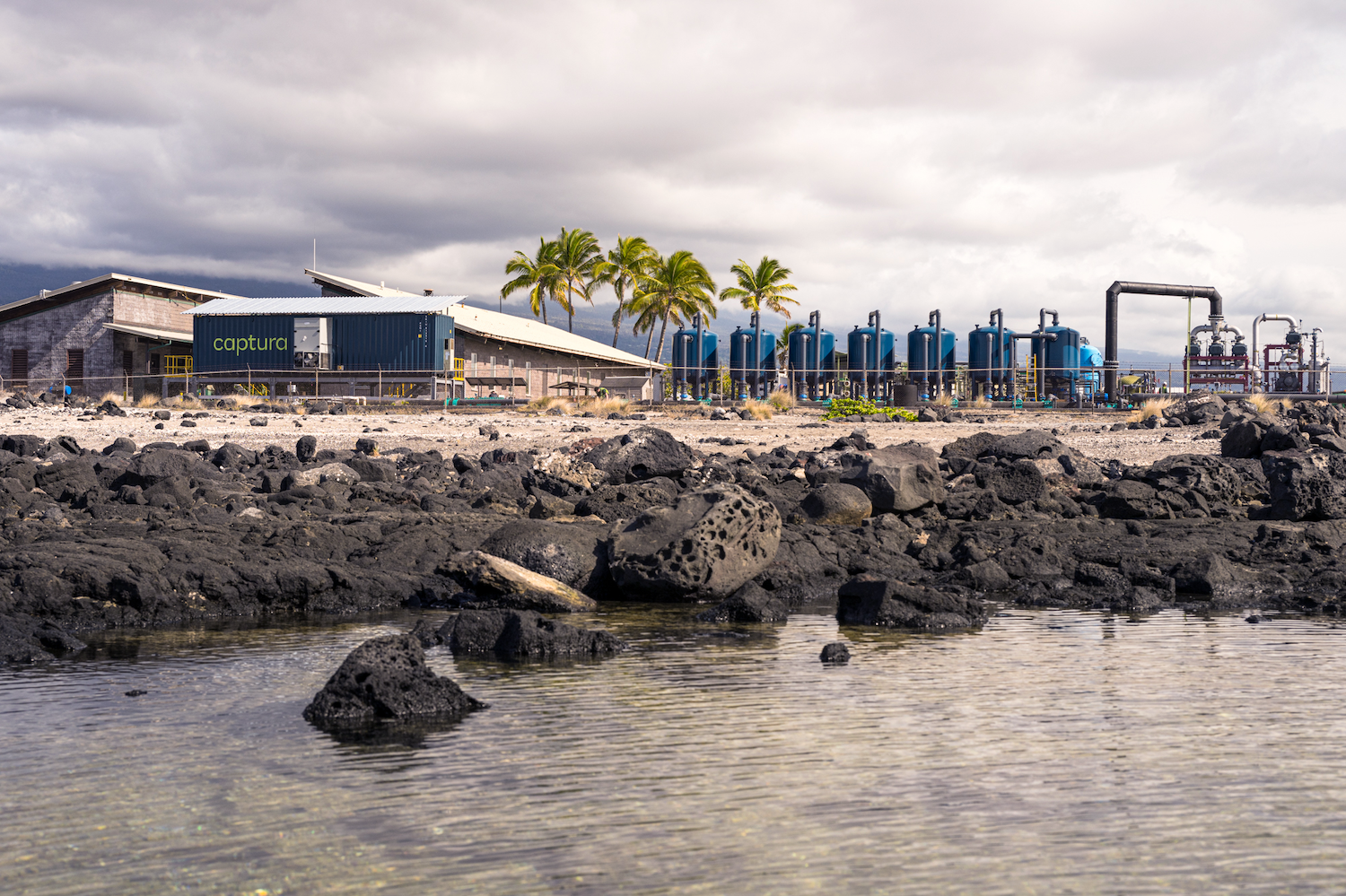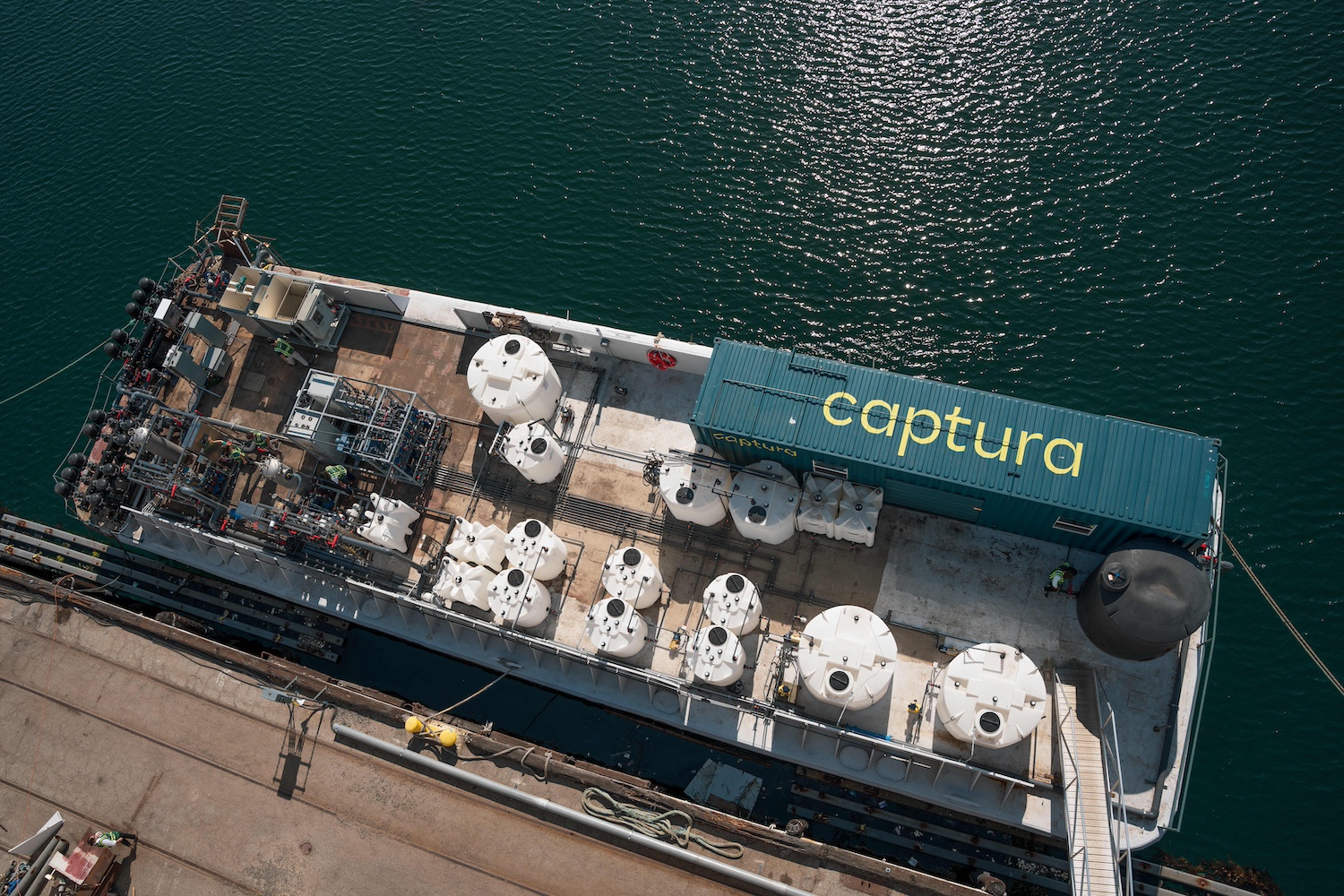
Captura's direct ocean capture pilot facility in Kona, Hawaii, enhances the ocean’s ability to absorb carbon dioxide. (Image courtesy of Captura.)
A drink becomes carbonated when carbon dioxide is added to make it fizzy. Anyone who opens a bottle of soda sees bubbles start to rise, and eventually, it turns flat. This is Henry’s Law in action.
The amount of carbon dioxide in the liquid is at balance with the amount of carbon dioxide putting pressure on it from above. When the seal is cracked, pressure is released, and the gas inside the soda is released to maintain the balance. The same is true for the reverse. If you were to increase the pressure on the bottle, more gas would dissolve inside the soda.
Captura, a California-based startup, is applying Henry’s Law to climate action through a process called direct ocean capture. It removes carbon dioxide from seawater, upsetting the gas balancing act, to enhance the ocean’s ability to absorb it from the atmosphere.
“If you remove carbon dioxide from the ocean, it disrupts the balance. The atmosphere then replenishes the carbon dioxide in the ocean,” Captura CEO and founder Steve Oldham told TriplePundit. “Now imagine doing that at the scale of the ocean, and you get a cost-effective way to remove large amounts of carbon from the atmosphere.”
The world’s oceans hold 60 times more carbon than the atmosphere and absorb nearly 30 percent of carbon dioxide from human activities, according to the Commonwealth Scientific and Industrial Research Organization.
Captura’s technology captures carbon dioxide using only ocean water and renewable electricity, without requiring input materials or producing waste, Oldham said. It delivers a clean, measurable stream of carbon dioxide, similar to direct air capture, but avoids the use of chemical absorbents.
“That means no materials need to be mined, transported, or disposed of — an enormous benefit when scaling this technology to the level of today’s global energy sector,” Oldham said.

The captured carbon dioxide is used for various applications, including sequestration for generating carbon credits, producing synthetic fuels, and serving as a climate-friendly feedstock for industrial use, Oldham told 3p. The startup is also exploring carbon dioxide supply opportunities for the food and beverage industry at its Hawaii plant.
One way Captura’s direct ocean capture carbon removal process stands out from the similar, but still different, direct air capture method is energy use. Captura’s method uses less energy than direct air capture and can operate on intermittent or curtailed power, Oldham said. This allows the system to run primarily on otherwise unused renewable energy — like surplus wind power at night — making it well-suited to align with the variable nature of wind, solar or wave energy.
“We design our plants to maximize use of this surplus energy, which is a significant value proposition,” Oldham said. “Our energy use is about 2 kilowatt-hours per kilogram of carbon dioxide removed, on the lower end of the direct air capture spectrum, and we expect roughly 50 percent of that energy to come from curtailed sources not otherwise in demand.”
One of the biggest hurdles Capture had to overcome was demonstrating that the technology worked.
“For technology, we had to show that the previous concerns raised by others when assessing ocean-based carbon removal are overcome by Captura's approach and our in-house electrodialysis technology,” Oldham said.
To do so, Captura operates two pilot sites: a facility at the Port of Los Angeles capable of capturing 100 tons of carbon dioxide each year, and one in Kona, Hawaii, capable of capturing 1,000 tons per year. Innovations are tested in Los Angeles, then scaled and validated in Hawaii before moving to commercial deployment.

The company is ready to build its first commercial-scale plant after successfully validating its technology through the two pilot projects. Captura secured an initial agreement and is pursuing others, but it needs supportive policy, commercial capital, or both to proceed, Oldham said.
The startup's other big challenge is demonstrating that its direct ocean capture process is benign to the ocean, Oldham told 3p. The company's approach of physically removing carbon dioxide from seawater helps reduce ocean acidification, unlike other marine-based carbon dioxide removal methods that add carbon back as bicarbonate, he said.
“We add no materials into the ocean and help mitigate ocean acidification, but we wanted to demonstrate that our process does not harm marine life,” Oldham said. “We've done that through a series of demonstrations and tests as part of an ongoing research program, the results from which we publish.”
Moving forward, the advantage of Captura’s approach is its flexibility. The company’s technology can be deployed almost anywhere with access to seawater. Since it doesn’t introduce new materials and generates no waste, the technology is “inherently scalable,” Oldham said.
“I see our solution as one essential piece of the broader climate toolkit. One major differentiator compared to other ocean-based carbon dioxide removal methods is that we don’t sequester carbon in the ocean — we extract it and produce a measurable stream of carbon dioxide,” he said. “This simplifies permitting and makes the carbon accounting more transparent and verifiable.”
Editor's note: An earlier version of this story stated Captura's Hawaii plant is located in Kaui. It is located in Kona, Hawaii, and the story was updated on June 17, 2025, to reflect this.

Gary E. Frank is a writer with more than 30 years of experience encompassing journalism, marketing, media relations, speech writing, university communications and corporate communications.














